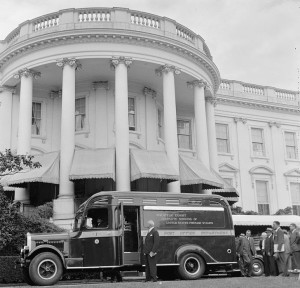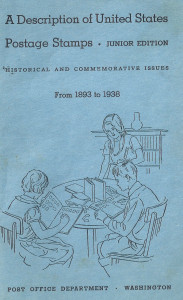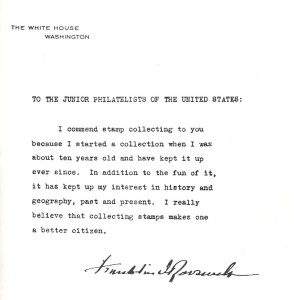Touring with Commemoratives as the National Story
¶ 1 Leave a comment on paragraph 1 0 Earning a commemorative held a great pay off for those advocating that their hero or historic event deserved a place in the corpus of American postage stamps. Figures such as Booker T. Washington and Susan B. Anthony became part of a mainstream visual narrative of American history. Spaces with their names appeared in empty stamp albums calling out to be filled. And, the USPOD invested in promotional efforts to encourage citizens of all ages to fill those pages and to read commemorative stamps in the context of American history.
¶ 2
Leave a comment on paragraph 2 0
 Philatelic truck at White House. Washington, D.C., May 9 (Library of Congress photo)
Philatelic truck at White House. Washington, D.C., May 9 (Library of Congress photo)
¶ 3 Leave a comment on paragraph 3 0 On the eve of entering the next world war, the USPOD went on a patriotic history tour of the US, using its catalog of commemorative stamps as the guide. In addition to the collecting and exhibiting efforts begun earlier in the century, the USPOD engaged in another intentional effort to encourage stamp collecting and reading the visual historical narratives printed on stamps. It outfitted a special truck designed to tour the US. The philatelic truck drew upon a successful tradition of circulating books and connecting communities through traveling library programs and bookmobiles in the early twentieth century. While bookmobiles served state-wide or regional populations, the philatelic truck’s audience was national. ((Derek Attig, “Here Comes the Bookmobile: Public Culture and the Shape of Belonging” (Dissertation, University of Illinois, Urbana-Champaign, 2014). )) With assistance from the Bureau of Engraving and Printing, the Philatelic Agency designed exhibit cases to fit inside of a panel truck that traveled 20,750 miles, visiting 490 towns and cities. The truck carried displays of US definitive, airmail, and commemorative stamps; postcards and envelopes; and a miniature printing press that stamped out souvenirs while demonstrating the printing processes. ((James H. Bruns and Bureau Issues Association, The Philatelic Truck (Takoma Park, Md.: Bureau Issues Association, 1982), 31–4. Fittingly, the Philatelic Truck parked outside of Wanamaker’s original department store in Philadelphia, appearing to be an homage Wanamaker’s role in the commemorative stamp program.))
¶ 4 Leave a comment on paragraph 4 0 Intending to stimulate interests of young Americans living in rural areas, the truck was a popular attraction every place it visited. Interest in the truck began before the tour routes were solidified. Many local postmasters and stamp club members wrote to Postmaster General Farley asking that the truck stop in their town. To encourage visitation and community participation while the truck was in town, local newspapers promoted the truck’s stop in their town and the mission of the USPOD’s stamp program. ((Bruns and Bureau Issues Association, The Philatelic Truck. United States Post Office Department, Annual Report of the Postmaster-General of the United States for the Fiscal Year Ending June 30, 1939 (Washington, DC: Government Printing Office, 1939), 58; United States Post Office Department, Annual Report of the Postmaster-General of the United States for the Fiscal Year Ending June 30, 1940 (Washington, DC: Government Printing Office, 1940), 53; United States Post Office Department, Annual Report of the Postmaster-General of the United States for the Fiscal Year Ending June 30, 1942 (Washington, DC: Government Printing Office, 1942), 21; and “Philatelic Truck Starts Nation-Wide Tour,” Mekeel’s Weekly Stamp News 53, no. 20 (May 15, 1939): 240.)) Like many traveling cultural exhibitions, the truck offered citizens who could not visit the home institutions in Washington an opportunity to view the catalog of US stamps.
¶ 5 Leave a comment on paragraph 5 0 While touring, the truck’s staff did not sell any stamps, but instead sold a small booklet intended for young collectors.
¶ 6
Leave a comment on paragraph 6 0
 A copy of A Description of United States Postage Stamps, Junior Edition cost visitors to the philatelic truck 10 cents (Author’s collection)
A copy of A Description of United States Postage Stamps, Junior Edition cost visitors to the philatelic truck 10 cents (Author’s collection)
¶ 7 Leave a comment on paragraph 7 0 The cover art pictured two girls and a boy organizing stamps into an album, illustrating that stamp collecting could be equally interesting to girls and boys. Inside the booklet, young readers found a complete illustrated catalog of US commemorative stamps from 1893-1938, and two welcoming notes: one from President Roosevelt and the other from Postmaster General Farley. ((Post Office Department, A Description of United States Postage Stamps, Junior Edition (Washington, DC: US Government Printing Office, 1939).))
¶ 8 Leave a comment on paragraph 8 0 Addressing the “Junior Philatelists of the United States,” Roosevelt wanted readers to know that he began collecting stamps as a child. Even as president, his stamp collecting practices helped him to “keep up” his interest in history and geography. Importantly, FDR closed his note by telling readers that he believed collecting stamps made individuals better citizens. ((Post Office Department, A Description of United States Postage Stamps)) A presidential endorsement carried weight and influence with parents, educators, and young collectors.
¶ 9
Leave a comment on paragraph 9 0
 Welcome letter from FDR, A Description of United States Postage Stamps, Junior Edition (Author’s collection)
Welcome letter from FDR, A Description of United States Postage Stamps, Junior Edition (Author’s collection)
¶ 10 Leave a comment on paragraph 10 0 Postmaster Farley more directly extolled the role and value represented with the catalog of special issue stamps:
¶ 11 Leave a comment on paragraph 11 0 The purpose of this booklet is to bring to the Youth of America the history of our great Nation as pictured on commemorative and other special issues of postage stamps, and to awaken in the citizens of tomorrow a keener sense of appreciation of the vision and faith of our forefathers who founded on these shores a new form of government, dedicated to the enduring principles of freedom and equality for all. ((Ibid., Foreward))
¶ 12 Leave a comment on paragraph 12 0 Farley clearly articulated his vision for reading American commemorative stamps as a picture book of American history. Stamps held transformative power that he argued could unite all citizens. This vision told through stamps is progressive and triumphalist, and ridden with holes in its historical perspective. The truck delivered this message as it traveled. The exhibits were popular with all audiences and the truck drew its largest crowds in cities, such as Pittsburgh and New York. USPOD officials believed that the effects of the traveling exhibits stimulated philately and gave the public a better understanding of US history as told through American stamps. The truck toured from May 1939 until December 1941, taking occasional breaks when postal officials granted time off for its crew. Touring stopped permanently after the Japanese attacks on Pearl Harbor on December 7, 1941. Visiting western states that December, the truck was ordered to San Diego for its last call where it retired permanently. ((Bruns and Bureau Issues Association, The Philatelic Truck. United States Post Office Department, Annual Report of the Postmaster-General of the United States for the Fiscal Year Ending June 30, 1939 (Washington, DC: Government Printing Office, 1939), 58; United States Post Office Department, Annual Report of the Postmaster-General of the United States for the Fiscal Year Ending June 30, 1940 (Washington, DC: Government Printing Office, 1940), 53; United States Post Office Department, Annual Report of the Postmaster-General of the United States for the Fiscal Year Ending June 30, 1942 (Washington, DC: Government Printing Office, 1942), 21; and “Philatelic Truck Starts Nation-Wide Tour,” Mekeel’s Weekly Stamp News 53, no. 20 (May 15, 1939): 240.))
Comments
0 Comments on the whole Page
Leave a comment on the whole Page
0 Comments on paragraph 1
Leave a comment on paragraph 1
0 Comments on paragraph 2
Leave a comment on paragraph 2
0 Comments on paragraph 3
Leave a comment on paragraph 3
0 Comments on paragraph 4
Leave a comment on paragraph 4
0 Comments on paragraph 5
Leave a comment on paragraph 5
0 Comments on paragraph 6
Leave a comment on paragraph 6
0 Comments on paragraph 7
Leave a comment on paragraph 7
0 Comments on paragraph 8
Leave a comment on paragraph 8
0 Comments on paragraph 9
Leave a comment on paragraph 9
0 Comments on paragraph 10
Leave a comment on paragraph 10
0 Comments on paragraph 11
Leave a comment on paragraph 11
0 Comments on paragraph 12
Leave a comment on paragraph 12